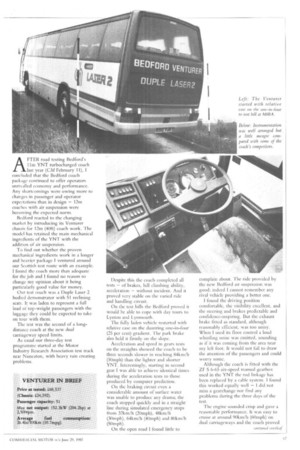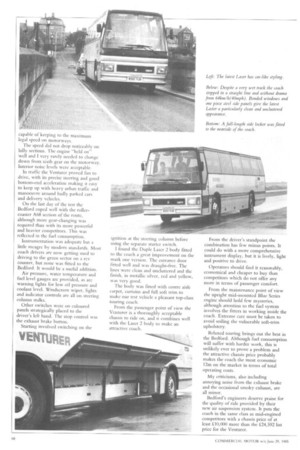VENTURER
Page 68

Page 69

Page 70

If you've noticed an error in this article please click here to report it so we can fix it.
MANY GAINS WITH THE
In response to a growing demand from operators for air-sprung coaches, Bedford unveiled its Venturer chassis at last year's Motor Show. More recently, Noel Millier spent three days testing a Laser 2 bodied version
AFTER road testing Bedford's llm YNT turbocharged coach last year (CM February 11), I concluded that the Bedford coach package continued to offer operators unrivalled economy and performance. Any shortcomings were owing more to changes in passenger and operator. expectations than in design — 12ni. coaches with air suspension were becoming the expected norm.
Bedford reacted to the changing market by introducing its Venturer chassis for 12m (401t) coach work. The model has retained the main mechanical ingredients of the YNT with the addition of air suspension.
To find out whether the proven mechanical ingredients work in a longer and heavier package I ventured around our Scottish test route with an example. I found the coach more than adequate for the job and I found no reason to change my opinion about it being particularly good value for money.
Our test coach was a Duple Laser 2 bodied demonstrator with 51 reclining seats. It was laden to represent a full load of top-weight passengers with the luggage they could be expected to take on tour with them.
The test was the second of a longdistance coach at the new dual carriageway speed limits.
As usual our three-day test programme started at the Motor Industry Research Association test track near Nuneaton, with heavy rain creating problems. Despite this the coach completed all tests — of brakes, hill climbing ability, acceleration — without incident. And it proved very stable on the varied ride and handling circuit.
On the test hills the Bedford proved it would be able' to cope with day tours to Lynton and Lynmouth.
The fully laden vehicle restarted with relative ease on the daunting one-in-four (25 per cent) gradient. The park brake also held it firmly on the slope.
Acceleration and speed in gears tests on the straights showed the coach to be three seconds slower in reaching 84km/h (50mph) than the lighter and shorter YNT. Interestingly, starting in second gear I was able to achieve identical times during the acceleration tests to those produced by computer prediction.
On the braking circuit even a considerable amount of surface water was unable to produce any drama; the coach stopped quickly and in a straight line during simulated emergency stops from 32km/h (20mph), 48km/h (30mph), 64km/h (40mph) and 80km/h (50mph).
On the open road I found little to complain about. The ride provided by the new Bedford air suspension was good; indeed I cannot remember any rival vehicle providing a better one.
I found the driving position comfortable, the visibility excellent, and the steering and brakes predictable and confidence-inspiring. But the exhaust brake fitted as standard, although reasonably efficient, was too noisy. When I used its floor control a loud whistling noise was emitted, sounding as if it was coming from the area near my left foot. It would not fail to draw the attention of the passengers and could worry some.
Although the coach is fitted with the ZF S 6-65 six-speed manual gearbox used in the YNT the rod linkage has been replaced by a cable system. I found this worked equally well — I did not miss a gearchange nor find any
problems during the three days of the test.
The engine sounded crisp and gave a reasonable performance. It was easy to cruise at around 90kin/h (60mph) on dual carriageways and the coach proved capable of keeping to the maximum legal speed on motorways.
The speed did not drop noticeably on hilly sections. The engine "held on" well and I very rarely needed to change down from sixth gear on the motorway. Interior noise levels were acceptable.
In traffic the Venturer proved fun to drive, with its precise steering and good bottom-end acceleration making it easy to keep up with heavy urban traffic and manoeuvre around badly parked cars and delivery vehicles.
On the last day of the test the Bedford coped well with the rollercoaster A68 section of the route, although more gear-changing was required than with its more powerful and heavier competitors. This was reflected in the fuel consumption.
Instrumentation was adequate but a little meagre by modern standards. Most coach drivers are now getting used to driving to the green sector on a rev counter, but none was fitted to the Bedford. It would be a useful addition.
Air pressure, water temperature and fuel level gauges arc provided, as arc warning lights for low oil pressure and coolant level. Windscreen wiper, lights and indicator controls are all on steering column stalks.
Other switches were on coloured panels strategically placed to the driver's left hand. The stop control was the exhaust brake button.
Starting involved switching on the ignition at the steering column before using the separate starter switch.
I found the Duple Laser 2 body fitted to the coach a great improvement on the mark one version. The entrance door fitted well and was draught-free. The lines were clean and uncluttered and the finish, in metallic silver, red and yellow, was very good.
The body was fitted with centre aisle carpet, curtains and full soft trim to make our test vehicle a pleasant top-class touring coach.
From the passenger point of view the Venturer is a thoroughly acceptable chassis to ride on, and it combines well with the Laser 2 body to make an attractive coach. From the driver's standpoint the combination has few minus points. It could do with a more comprehensive instrument display, but it is lively, light and positive to drive.
Operators should find it reasonably, economical and cheaper to buy than competitors which do not offer any more in terms of passenger comfort.
From the maintenance point of view the upright mid-mounted Blue Series engine should hold few mysteries, although attention to the fuel system involves the fitters in working inside the coach. Extreme care must be taken to avoid soiling the vulnerable soft-trim upholstery.
Relaxed touring brings out the best in the Bedford. Although fuel consumption will suffer with harder work, this is unlikely ever to prove a problem and the attractive chassis price probably makes the coach the most economic 12m on the market in terms of total operating costs.
My criticisms, also including annoying noise from the exhaust brake and the occasional smoky exhaust, are all minor.
Bedford's engineers deserve praise for the quality of ride provided by their new air suspension system. It puts the coach in the same class as mid-engined competitors with a chassis price of at least £10,000 more than the £24,592 list price for the Venturer.




































































































